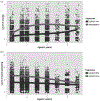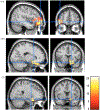Prefrontal cortex and amygdala anatomy in youth with persistent levels of harsh parenting practices and subclinical anxiety symptoms over time during childhood
- PMID: 33745487
- PMCID: PMC11784656
- DOI: 10.1017/S0954579420001716
Prefrontal cortex and amygdala anatomy in youth with persistent levels of harsh parenting practices and subclinical anxiety symptoms over time during childhood
Abstract
Childhood adversity and anxiety have been associated with increased risk for internalizing disorders later in life and with a range of brain structural abnormalities. However, few studies have examined the link between harsh parenting practices and brain anatomy, outside of severe maltreatment or psychopathology. Moreover, to our knowledge, there has been no research on parenting and subclinical anxiety symptoms which remain persistent over time during childhood (i.e., between 2.5 and 9 years old). Here, we examined data in 94 youth, divided into four cells based on their levels of coercive parenting (high / low) and of anxiety (high / low) between 2.5 and 9 years old. Anatomical images were analyzed using voxel-based morphometry (VBM) and FreeSurfer. Smaller gray matter volumes in the prefrontal cortex regions and in the amygdala were observed in youth with high versus low levels of harsh parenting over time. In addition, we observed significant interaction effects between parenting practices and subclinical anxiety symptoms in rostral anterior cingulate cortical thickness and in amygdala volume. These youth should be followed further in time to identify which youth will or will not go on to develop an anxiety disorder, and to understand factors associated with the development of sustained anxiety psychopathology.
Keywords: FreeSurfer; VBM; anxiety; internalized disorders; parental practices.
Conflict of interest statement
Figures




Similar articles
-
Development of White Matter Microstructure and Intrinsic Functional Connectivity Between the Amygdala and Ventromedial Prefrontal Cortex: Associations With Anxiety and Depression.Biol Psychiatry. 2017 Oct 1;82(7):511-521. doi: 10.1016/j.biopsych.2017.01.008. Epub 2017 Jan 17. Biol Psychiatry. 2017. PMID: 28274468 Free PMC article.
-
Prospective longitudinal associations between harsh parenting and corticolimbic function during adolescence.Dev Psychopathol. 2022 Aug;34(3):981-996. doi: 10.1017/S0954579420001583. Epub 2021 Jan 25. Dev Psychopathol. 2022. PMID: 33487207 Free PMC article.
-
Amygdala, Hippocampus, and Ventral Medial Prefrontal Cortex Volumes Differ in Maltreated Youth with and without Chronic Posttraumatic Stress Disorder.Neuropsychopharmacology. 2016 Feb;41(3):791-801. doi: 10.1038/npp.2015.205. Epub 2015 Jul 14. Neuropsychopharmacology. 2016. PMID: 26171720 Free PMC article.
-
Cortical and Subcortical Gray Matter Volume in Youths With Conduct Problems: A Meta-analysis.JAMA Psychiatry. 2016 Jan;73(1):64-72. doi: 10.1001/jamapsychiatry.2015.2423. JAMA Psychiatry. 2016. PMID: 26650724 Review.
-
Amygdala hyper-connectivity in a mouse model of unpredictable early life stress.Transl Psychiatry. 2018 Feb 21;8(1):49. doi: 10.1038/s41398-018-0092-z. Transl Psychiatry. 2018. PMID: 29463821 Free PMC article. Review.
Cited by
-
Effects of Parental Internalizing and Externalizing Behavior Problems on Children's Limbic Brain Structures-An MRI Study.Brain Sci. 2022 Sep 29;12(10):1319. doi: 10.3390/brainsci12101319. Brain Sci. 2022. PMID: 36291253 Free PMC article.
-
A Narrative Review of Methodological Considerations in Magnetic Resonance Imaging of Offspring Brain Development and the Influence of Parenting.Front Hum Neurosci. 2021 Aug 19;15:694845. doi: 10.3389/fnhum.2021.694845. eCollection 2021. Front Hum Neurosci. 2021. PMID: 34489661 Free PMC article. Review.
-
Early childhood family threat and longitudinal amygdala-mPFC circuit development: Examining cortical thickness and gray matter-white matter contrast.Dev Cogn Neurosci. 2024 Dec;70:101462. doi: 10.1016/j.dcn.2024.101462. Epub 2024 Oct 16. Dev Cogn Neurosci. 2024. PMID: 39418759 Free PMC article.
-
Parent Psychopathology and Behavioral Effects on Child Brain-Symptom Networks in the ABCD Study.J Am Acad Child Adolesc Psychiatry. 2024 Oct;63(10):1024-1034. doi: 10.1016/j.jaac.2023.12.016. Epub 2024 Mar 22. J Am Acad Child Adolesc Psychiatry. 2024. PMID: 38522613 Free PMC article.
-
Involving Parents in the Management and Treatment of Youth Anxiety.Curr Psychiatry Rep. 2025 Jul;27(7):441-449. doi: 10.1007/s11920-025-01614-8. Epub 2025 May 9. Curr Psychiatry Rep. 2025. PMID: 40343658 Review.
References
-
- Achenbach TM (1991). Child behavior checklist. Burlington, VT: Department of Psychiatry, University of Vermont.
Publication types
MeSH terms
Grants and funding
LinkOut - more resources
Full Text Sources
Other Literature Sources
Medical

